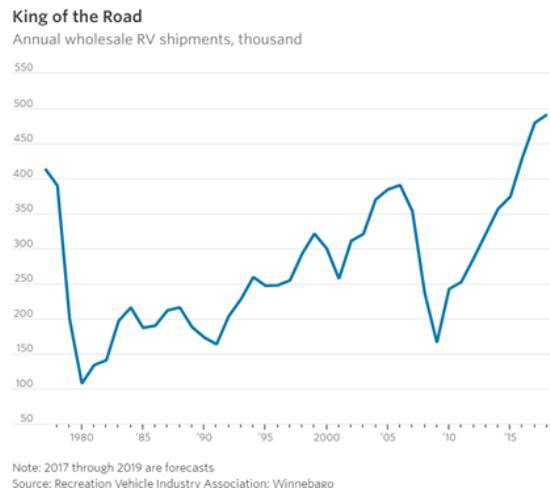Six months ago, recreational vehicle sales were booming and the companies making those expensive, gas-guzzling rolling houses were riding high. See The Perfect Crash Indicator Is Flashing Red.
And now? Same story, even bigger numbers – but with a decidedly more skeptical treatment in the media:
(Wall Street Journal) – For anyone who has gotten stuck on a mountain road behind a massive recreational vehicle, get used to it, there are a lot more on the highway.
Recreational vehicles, ranging from bus-sized motor homes to retro trailers, have been a boom-and-bust industry since they first became popular in the early 1970s. Now a wave of retiring baby boomers and a surprisingly young new fan base have sent U.S. unit sales above their housing boom peak. Shares of the two leading manufacturers of RVs,Thor Industries and smaller Winnebago Industries each hit records last week.
The fundamentals—fuel prices, interest rates, disposable income and demographics—all look solid. That has the Recreation Vehicle Industry Association projecting a further jump this year and next. Despite that, delighted investors might want to unhitch themselves from these stocks. When things go badly for the economy, they go very badly for RV makers.
Shares of one-time industry leader Winnebago Industries plunged by 94% from peak to trough in the first 1970s energy crisis and by 78% in the second one. A lack of easy credit and consumer confidence can be just as devastating. Shares fell 92% between their housing boom peak and housing bust trough, while wholesale RV shipments fell by two-thirds.

While an energy shock or sharp economic downturn don’t loom on the immediate horizon, the industry isn’t quite as robust as unit sales figures suggest. Younger “glampers” increasingly are opting for cheaper, towable vehicles, not huge, motorized ones. Leading RV retailer Camping World Holdings reported a 14.5% increase in same-store new vehicle sales in its third quarter, compared with a year earlier, even as the average price of new vehicles sold fell by 1.6% because of the shift to cheaper offerings.
Given the industry’s sharp cyclicality, RV makers really should trade more like auto manufacturers, yet the publicly traded industry leaders—No. 2 by revenue Forest River, is a subsidiary of Warren Buffett’s Berkshire Hathaway—have an average forward price-to-earnings ratio of 17.4 times, almost 2½ times the average of seven auto companies, according to FactSet. The leading dealership, Camping World Holdings, commands a 40% premium to a basket of auto dealers, but that seems less egregious given the fat margins it earns from services and used RV sales, compared with new vehicles.
For the manufacturers, though, it is about time for a rest stop.













Leave A Comment